A quality control resume showcases your qualifications and expertise in performing the duties and responsibilities of a quality controller. It demonstrates your ability to ensure that products and services adhere to required specifications and standards.
It is crucial for maintaining customer satisfaction and retaining market share. Therefore, your resume must highlight your past experiences, project contributions, positive impacts, and other relevant details that make you an ideal candidate for the role.
This article will cover the following aspects to help you market yourself effectively in your job application:
- Formatting tips for a professional resume
- A step-by-step guide on how to create resume
- Examples of proper and improper structure and phrasing for each resume section
- Tips for crafting a strong resume that convinces potential employers to hire you
Formatting Resume
As a professional in the job market, it’s essential to recognize that the layout of your resume plays a vital role in the impression it makes on potential employers. Here are some key tips for formatting your resume to ensure that it stands out in a positive way.
Firstly, it’s important to choose the appropriate resume format based on your level of experience, expertise, and the employer’s requirements. There are three primary formats to choose from – chronological, functional, or combination.
Typically, for these job applications, the chronological format is preferred as it is ATS (applicant tracking system) friendly and favored by employers. However, if you have career gaps due to a change in career, functional or combination formats may be more suitable.
Secondly, ensure that your resume is structured in a clear and organized manner. Use section headings to distinguish each section, and include your contact information at the top for easy reference.
Lastly, make sure that your resume is easy to read by selecting a legible and professional font. By following these formatting tips, you can create a resume that effectively showcases your skills and experience, ultimately increasing your chances of landing the job you desire.
Write Perfect Resume Summary or Objective
Your resume should begin with either a resume summary or objective. A resume summary is suitable for experienced professionals with over three years of experience, while an objective statement is used for entry-level applicants who lack professional experience.
A summary focuses on your career achievements, previous responsibilities, and notable events in your professional experience. An objective statement highlights your career goals and strongest qualities in lieu of experience.
Keep the following tips in mind when writing this section of your resume:
- Use this section as an elevator pitch to convince the recruiter that your resume is worth considering.
- An effective summary or objective statement increases your chances of being selected for the position.
- Limit the statement to 3-5 lines to provide a concise introduction to the recruiter.
Although the summary or objective statement is placed at the top of the page, it’s often best to write it after completing the other sections, so it accurately captures the resume’s content.
Here are examples of a summary or objective statement:
EXAMPLE 1– Good
Detail-oriented and adaptable entry-level inspector with quick learning ability, seeking a mentorship opportunity to achieve career goals in quality control. Committed to delivering accurate results consistently.
EXAMPLE 2– bad
A capable and dedicated analyst seeking a job at your company. I have the ability to follow procedures effectively. My abilities, experience, and competencies will enable me to deliver results and be a valuable addition to your company.
Nail Your Resume Education Section
The education section is where you provide details about your degrees and certifications. Include the name of the institution, your GPA (Grade Point Average; if impressive), graduation date (if less than 15 years ago), relevant coursework, academic projects, and any honors, awards, or distinctions you received. If you have multiple degrees, list them in reverse chronological order, with the most recent degree first. If you have yet to graduate, simply provide the expected graduation date.
The placement of this section depends on your situation. Recent graduates should place it before their professional experience. As your experience increases, this section becomes shorter.
See the examples below:
GOOD EXAMPLE
EDUCATION
Bachelor’s Degree in Quality Control
Vanguard University, Pretoria, GA
Graduation: 2016
GPA: 3.9
Completed coursework in Business, System Optimization, Mathematics, R-Modeling, Simulation, and Database Management
Certified by the American Society for Quality Control (ASQC)
BAD EXAMPLE
Bachelor’s Degree in Business, 2016
The John Hawkins University, Columbia, WA
Highlight Your Skills for Resumes
The skills section is a crucial component of your resume, as it offers a comprehensive overview of your capabilities. It allows recruiters and hiring managers to evaluate your abilities in a practical manner.
This section summarizes the knowledge, skills, and abilities you’ve developed throughout your education and professional career, enabling the recruiter to determine if you are a suitable candidate for the role.
Be sure to include a balanced mix of soft and technical skills relevant to the position, with an emphasis on technical skills. Use keywords from the job description in this section and list 6-12 skills.
Consider the following categories and examples of skills to include in your resume:
- Procedural Skills: Highlight your ability to follow established procedures diligently to maintain quality control. Showcase your familiarity with standard operating procedures (SOPs), work instructions, and best practices within the industry.
- Quality Check Skills: Emphasize your expertise in performing quality checks using various techniques and tools to ensure products meet the requirements of managers and customers. Explain your proficiency in conducting inspections, audits, and tests throughout the production process.
- Product Quality Skills: Demonstrate your understanding of product quality processes and continuous improvement methodologies aimed at reducing defects and enhancing customer satisfaction. Mention your experience in implementing and monitoring quality management systems (QMS) and utilizing root cause analysis to identify areas of improvement.
- Communication Skills: Showcase your ability to communicate effectively, both verbally and in writing, as information flow is crucial in quality control. Highlight your experience in preparing reports, collaborating with cross-functional teams, and providing clear instructions to production staff.
- Safety Standard Skills: Indicate your ability to follow safety standards, adhere to regulations, and provide authentic and dependable safety data. Mention your familiarity with OSHA regulations, hazard analysis, and risk assessment methodologies.
- Quality Standard Skills: Illustrate your knowledge of quality standards, such as ISO 9001, Six Sigma, or Lean Manufacturing, aimed at ensuring all products meet a predetermined set of customer requirements, rules, regulations, and product characteristics.
- Laboratory Equipment Skills (if applicable): Prove your ability to use, operate, and maintain laboratory equipment for testing various products or services. Describe your experience with specific equipment, calibration, and maintenance procedures.
- Analytical and Problem-Solving Skills: Showcase your ability to analyze data, identify trends, and troubleshoot quality-related issues. Emphasize your critical thinking and data-driven decision-making abilities.
- Technical Skills: List any specialized software, tools, or techniques you are proficient in, such as statistical process control (SPC), failure modes and effects analysis (FMEA), or such software.
- Time Management and Organizational Skills: Demonstrate your ability to prioritize tasks, meet deadlines, and maintain accurate records in a fast-paced, dynamic environment.
Technical and Industry-Specific Skills, grouped into relevant categories:
| Skills | |
| Product Quality Control | Acceptance Sampling |
| FDA Compliance & Regulations | GMP Pharmaceutical Quality Control |
| Measurement Gauges (Calipers, Micrometers, Microscopes, Comparators) | Process Protocol |
| Control Charts | Process Control |
| Current Good Manufacturing Practices (cGMP) | First Article Inspection (FAI) Practice |
| Risk Assessment | Test Case Design |
| Statistical Analysis | Quality Control Inspection |
| OSHA Information Quality Guidelines | Performance Testing |
| Product Assessment and Testing | Vendor Management |
| Safety Standards | Process Improvement |
Software and tools:
| Skills | |
| Microsoft Word | Google Docs |
| Data Collation | Report and Documentation |
Soft skills
| Skills | |
| Detail-Oriented | Multi-tasking Skills |
| Accountability | Teamwork Skills |
| Project Management Skills | Time Management Skills |
| Problem-Solving Skills | Interpersonal Skills |
| Critical Thinking Skills | Decision Making Skills |
| Good Communication Skills | Behavioral Analysis |
Mathematical and analytical skill:
| Skills |
| Mathematics & Statistics |
Provide Your Experience
The experience section provides information on the jobs you have held in the past and any on-duty accomplishments you attained. Mention the job title, company name, and year of employment. Remember to highlight the specific job duties you performed on a day-to-day basis or the tasks that contributed most to results.
This information can be given in the following formats:
STAR format
This format provides information as follows: Situation + task + action + result. The situation refers to a situation, event, or challenge, the task refers to the task you were assigned to do, the action refers to what you did, and the result refers to the outcome of your action.
EXAMPLE
Approving product packaging designs for over 20 products before products could be launched into the market, which resulted in a steady increase in sales during my tenure.
One-liners
You can also describe the responsibilities you were assigned in your previous jobs in one-liners. You should start your lines with action verbs to avoid repetition or redundancy.
EXAMPLE
-Approving product packaging of over 20 products before they are launched into the market.
-Ensured product packages were up to the customer’s standards, which resulted in a steady increase in sales over the five years I worked at ABC Company.
Grouping and highlighting
You can also use the grouping and highlighting format where you provide your professional experience by outlining your duties and achievements and highlighting the key information.
EXAMPLE
–Approving product packaging of over 20 products before they are launched into the market.
-Ensured product packages were up to the customer’s standards which resulted in a steady increase in sales over the five years I worked at ABC Company.
Also, describe any projects you took charge of or led a team on their completion. The projects must be relevant to the position and show your contribution to the company. To add the projects, create a section under experience and outline them.
Use the following guidelines when adding the projects to your resume:
- Outline the name of the project, client’s name (if applicable), start and date of completion, and project’s location.
- Use short descriptions. Use one-liners to describe the duties and responsibilities.
- Give achievements using figures to show the outcome of your contributions to the project.
- Only include a project if it portrays skills and expertise relevant to the role.
EXAMPLE
Relevant Projects
Project: Consultancy on the introduction of product X
Client: HBI Manufacturers, May – July 2021
-Inspected the prototype of Product X to ascertain that it meets the America Consumer Protection laws.
-Prepared compliance reports and prepared approval application requests to the Consumer Products Oversight Agency (CPOA).
Given below are examples of how to structure the experience section:
EXAMPLE– Good
WORK EXPERIENCE
Quality Control Inspector 2014-2021
Pipes International, Knoxville, TN
-Calibrating 10+ equipment used in the production process to ensure instruments are functioning properly and with precision.
-Collected customer complaints and suggestions and used the information to recommend what features and adjustments should be added to more than 15 products.
-Supervised a 10-member team in the quality control department.
EXAMPLE– BAD
Quality Control Inspector 2016-2018
Yorkshire Ceramics Company, Pretoria, GA
-Prepared reports for the quality control department.
-Collected data and analyzed it to device procedures to improve product quality
-Instituted measures to prevent further contamination.
Add Additional Sections
Your resume can have other additional sections if there’s information that you would like to relay to the recruiter. This section can report on a wide range of things such as personal interests, volunteer work, certifications, professional milestones, resume language skills, etc.
EXAMPLE
Examples of certifications you can include:
- Quality Control Inspector
- OSHA Safety Certificate
- Certified Welding Inspector (CWI)
- Forklift Safety and Inspector
- Certified Professional – Food Safety (CP-FS)
- Master Quality Manager (MQM)
- Incident Safety Officer – Fire Suppression Certification (ISO)
- Aboveground Storage Tanks Inspector Certification (API)
- International Accredited Business Accountant (IABA)
Resume Templates
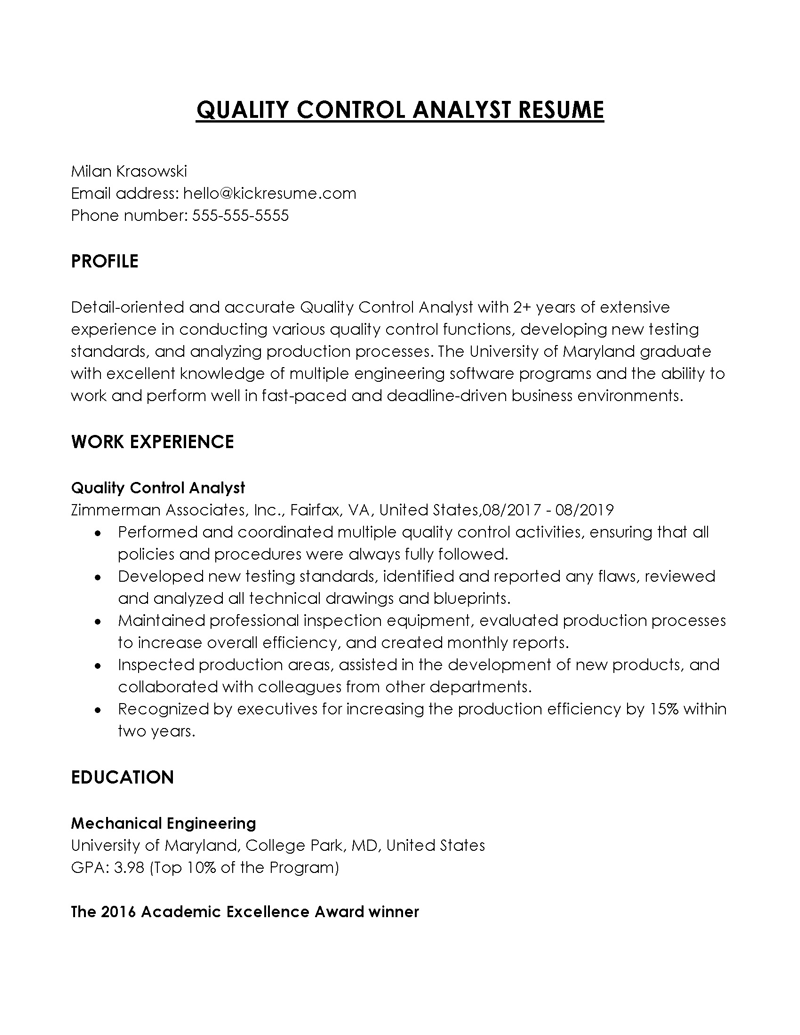
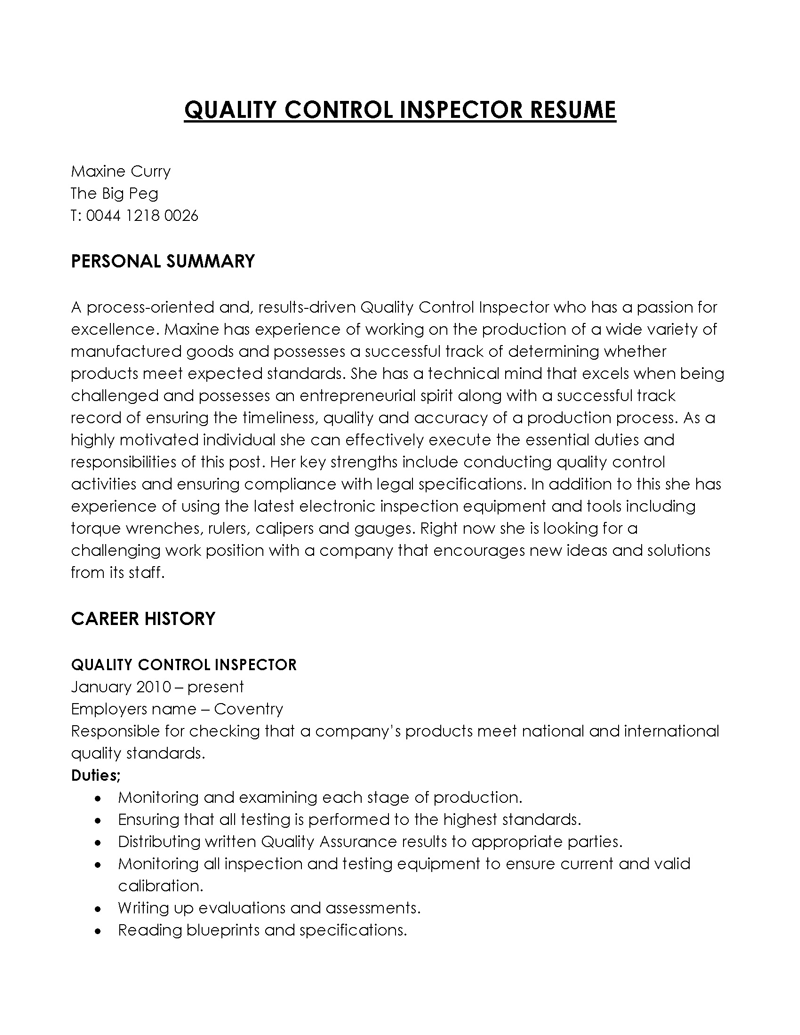
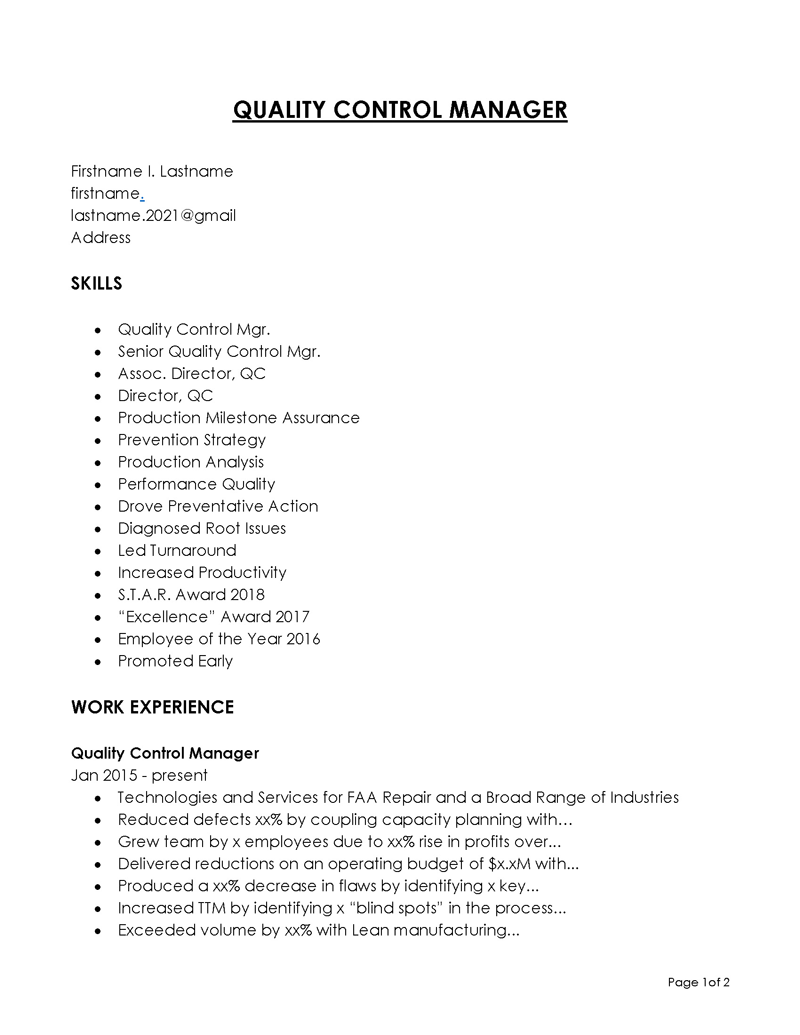
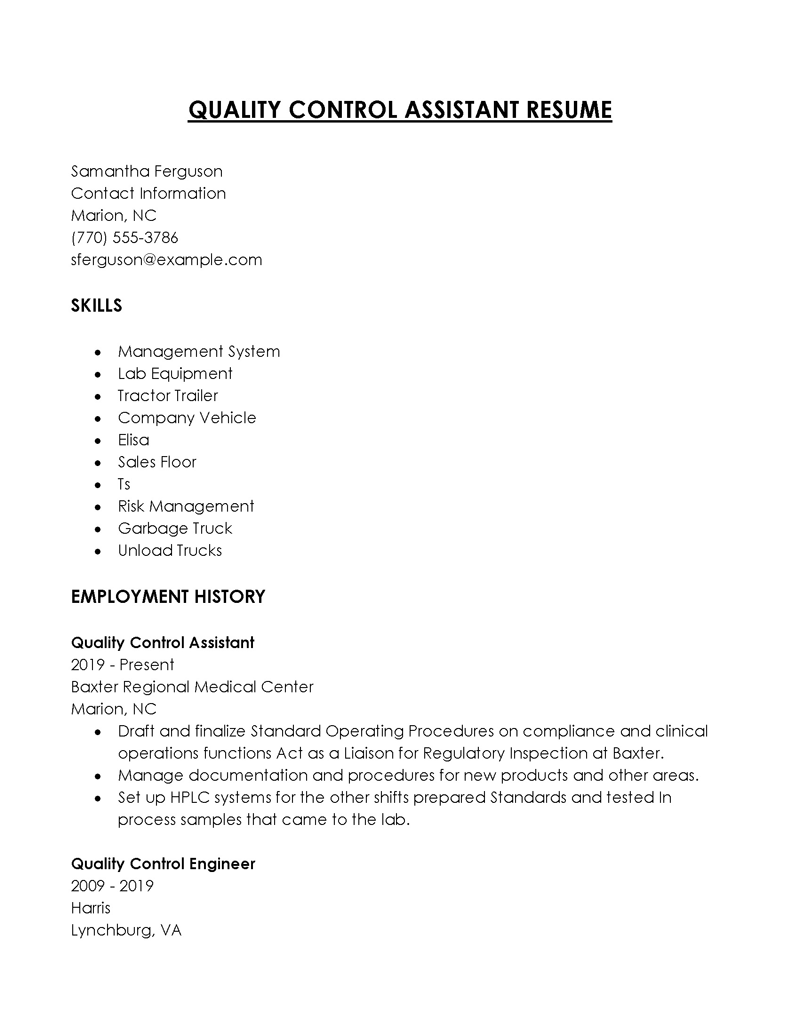
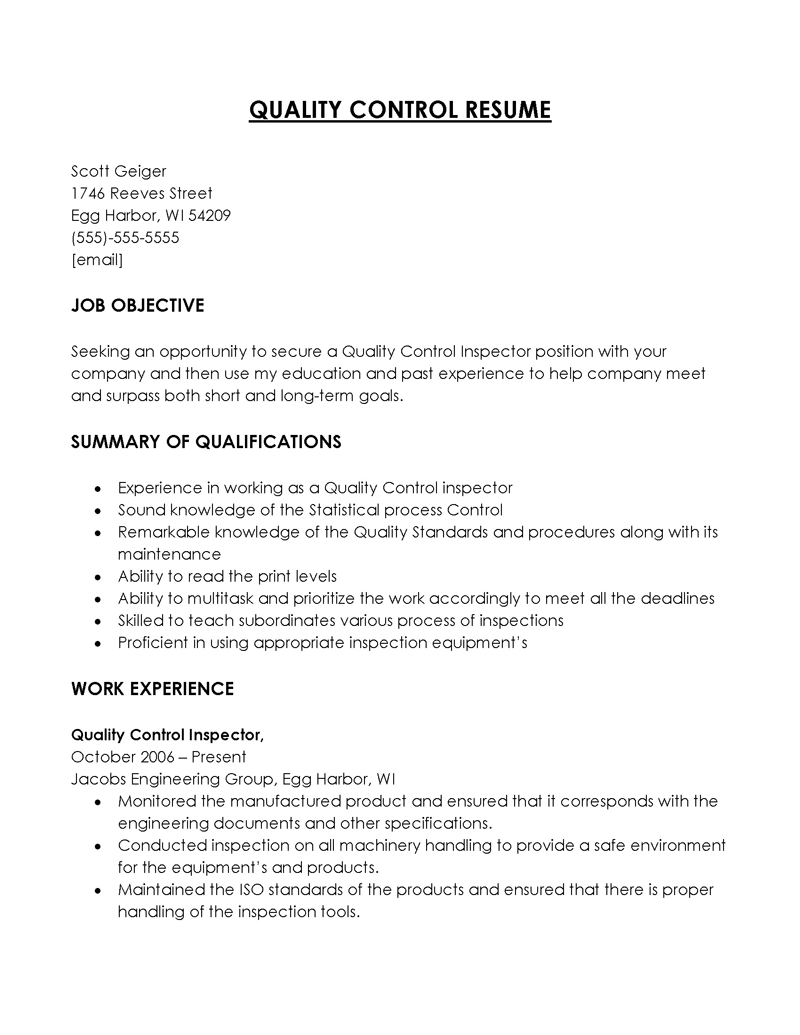
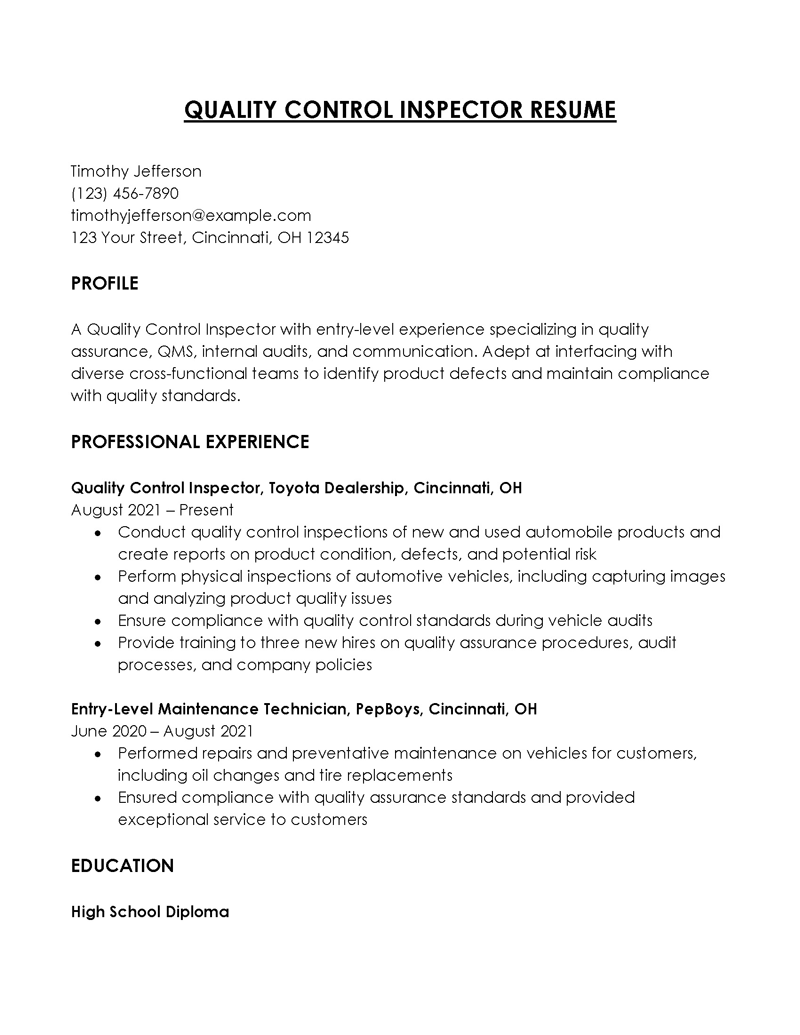
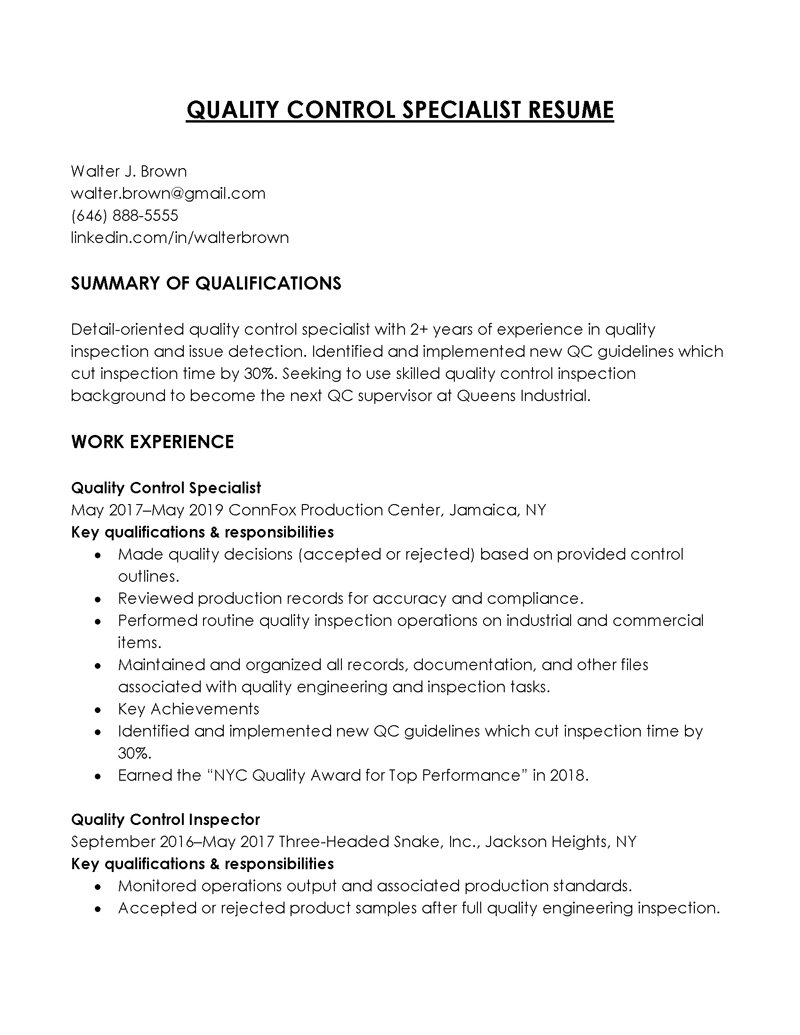
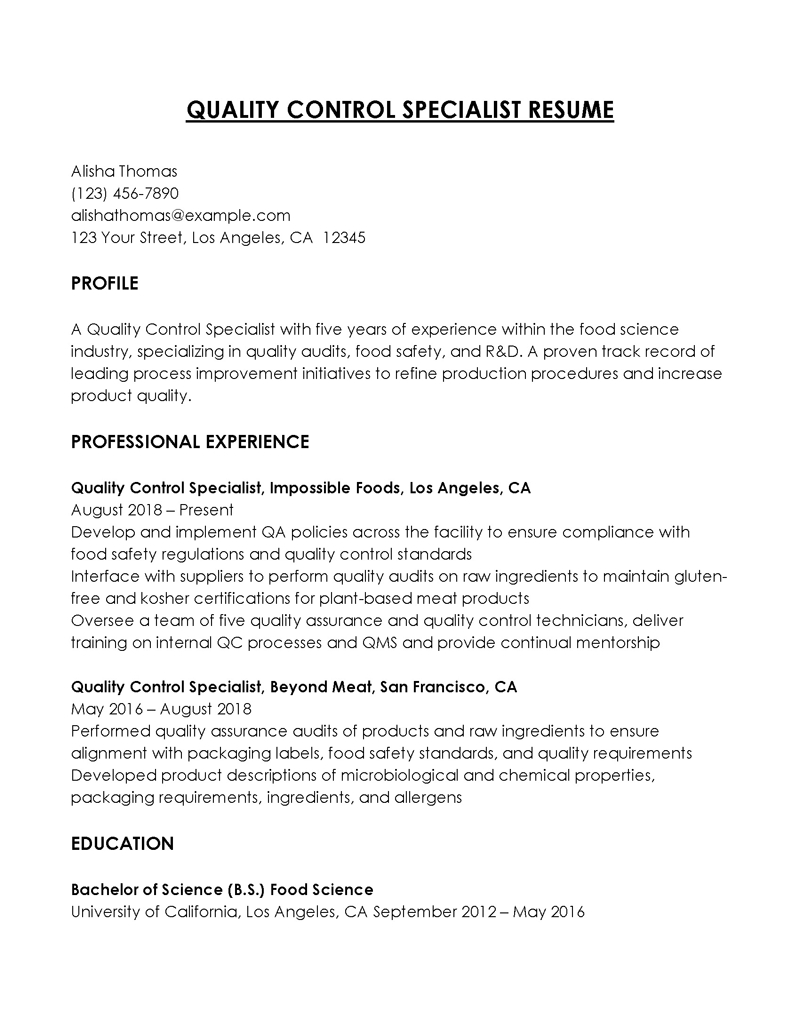
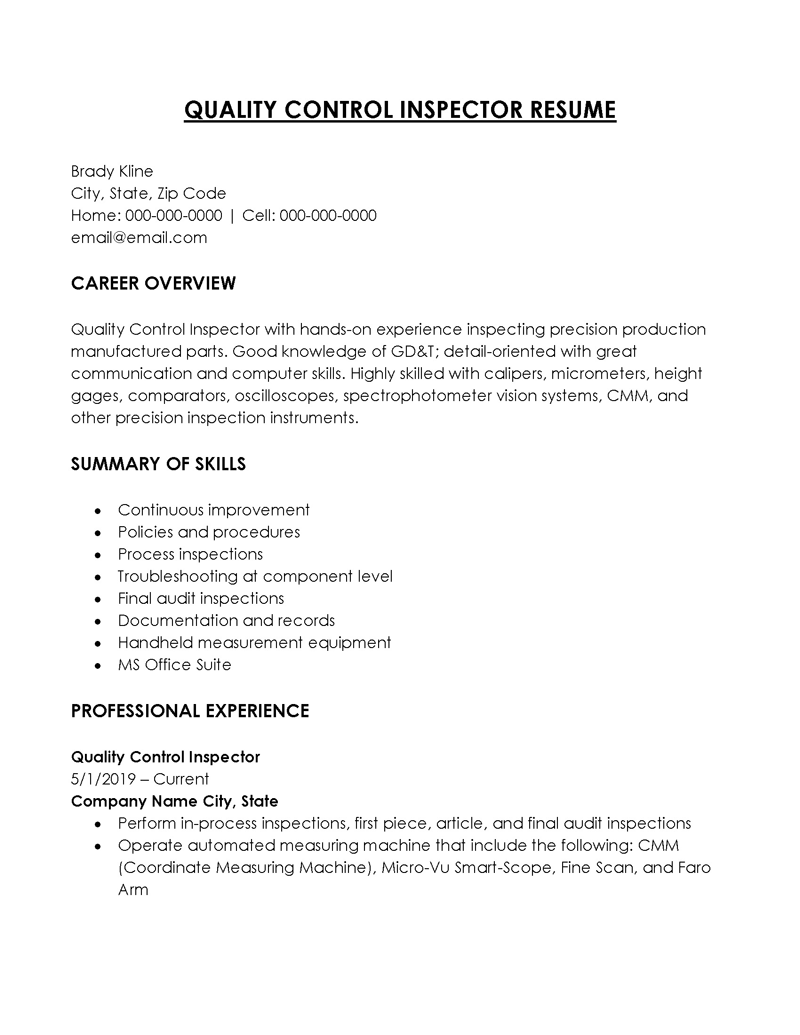
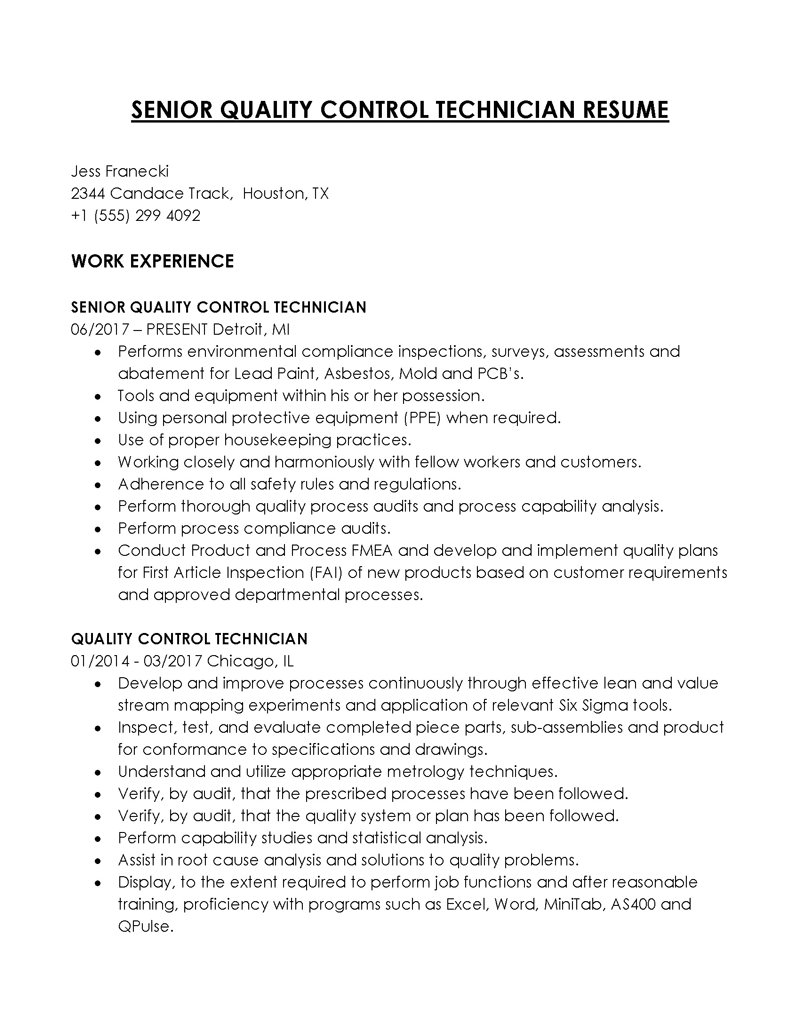
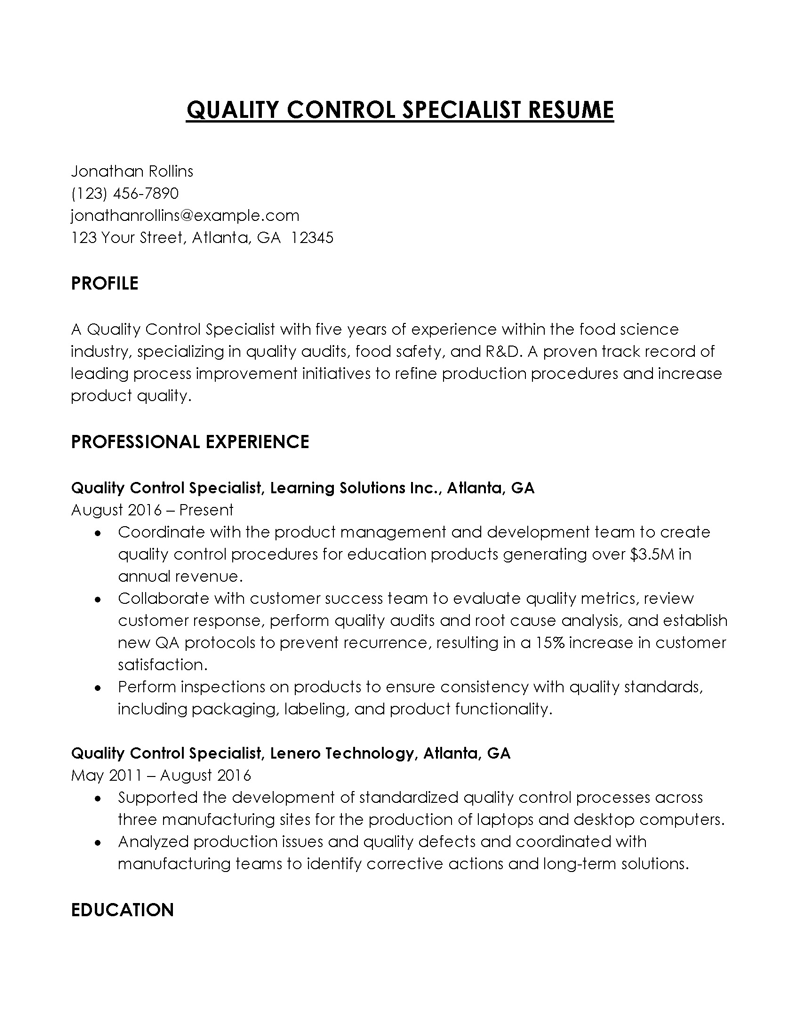
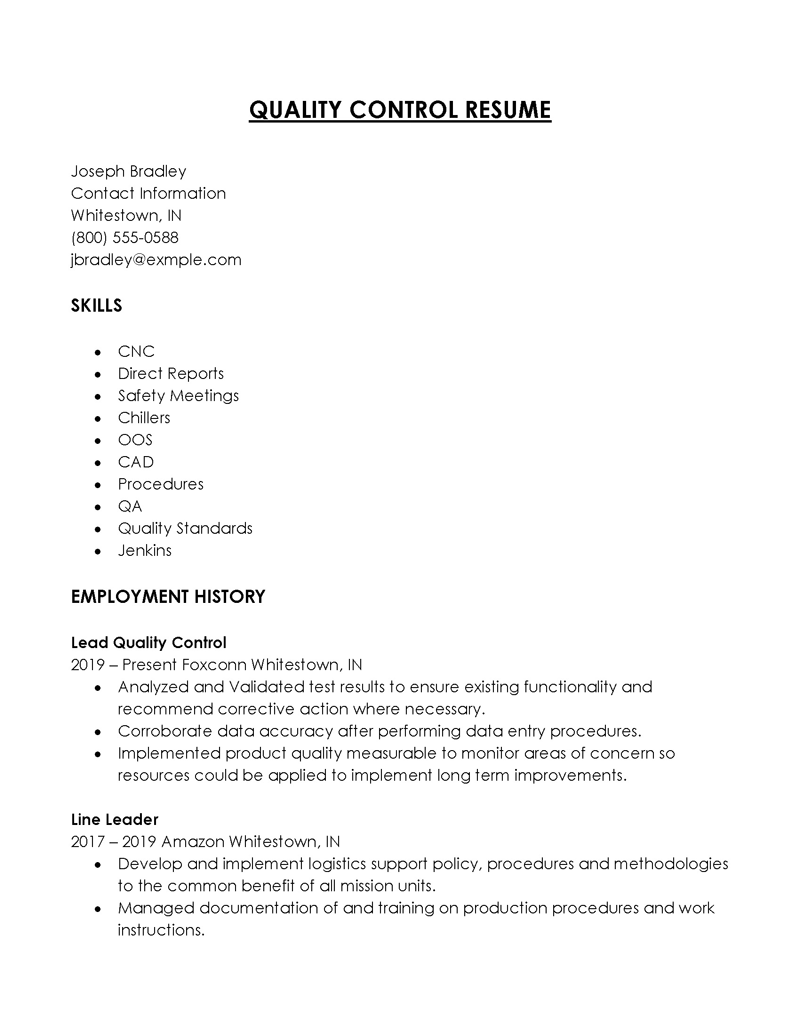
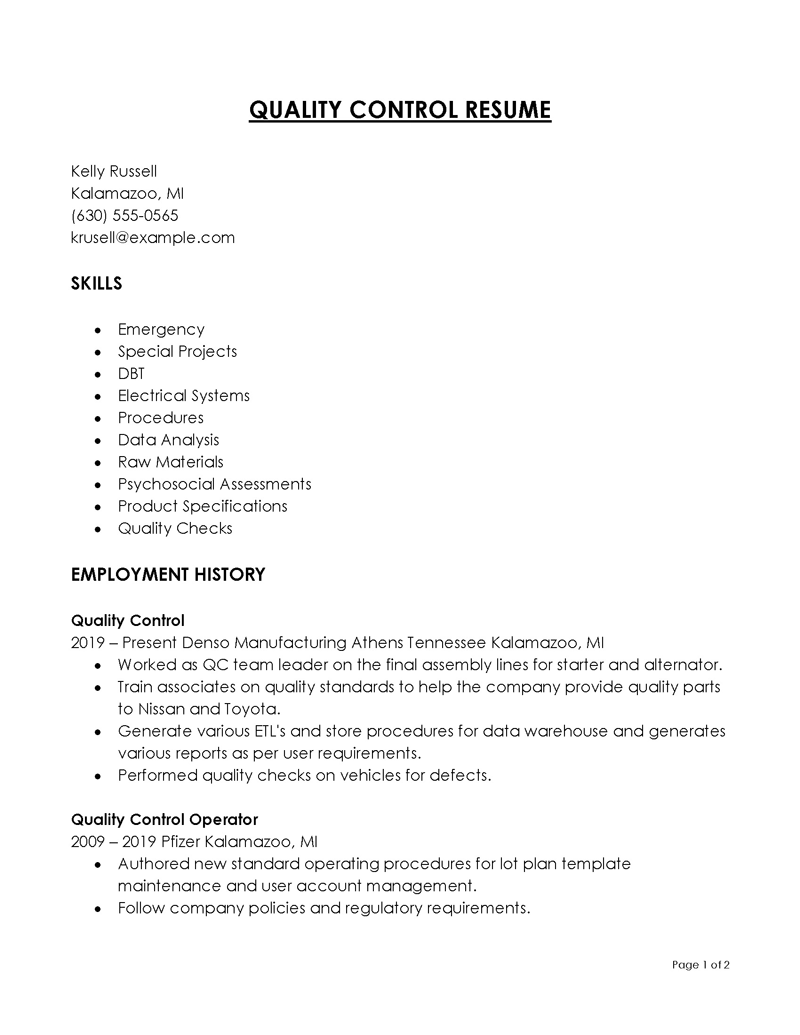
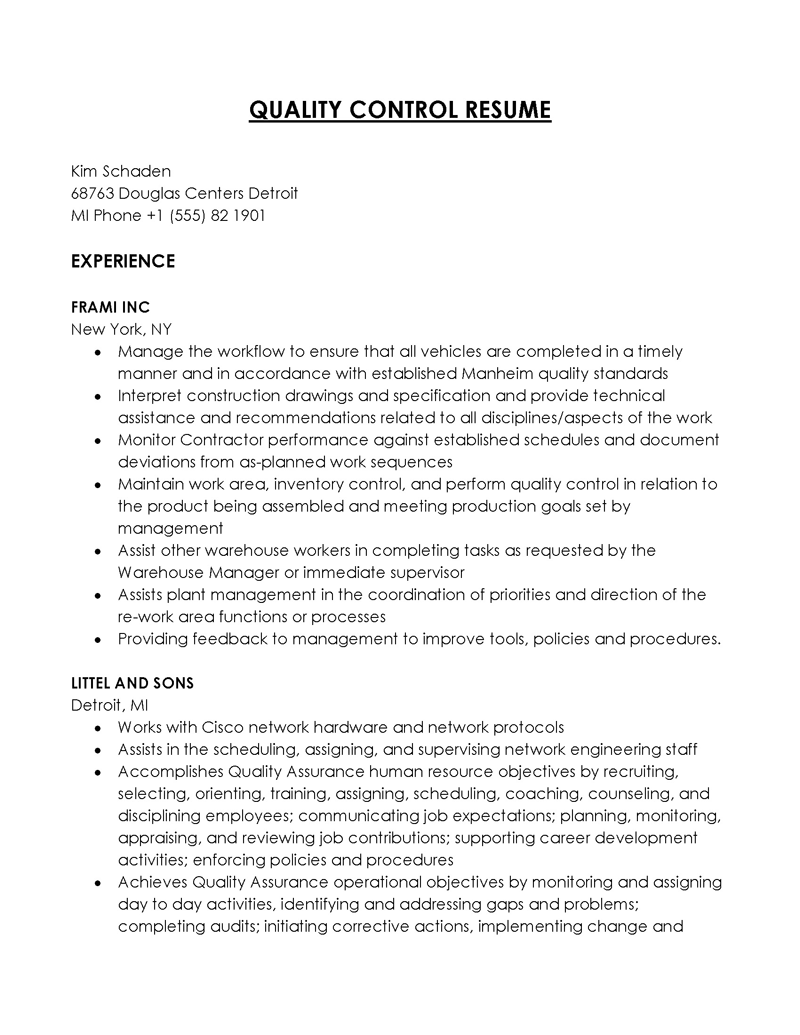
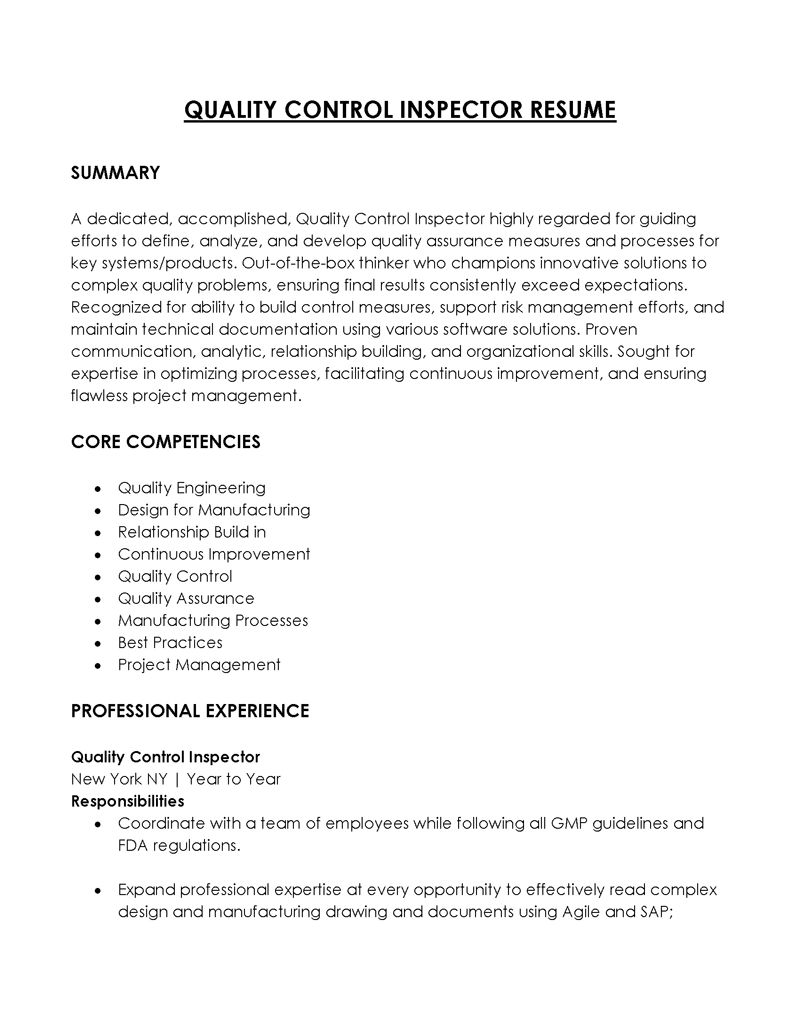
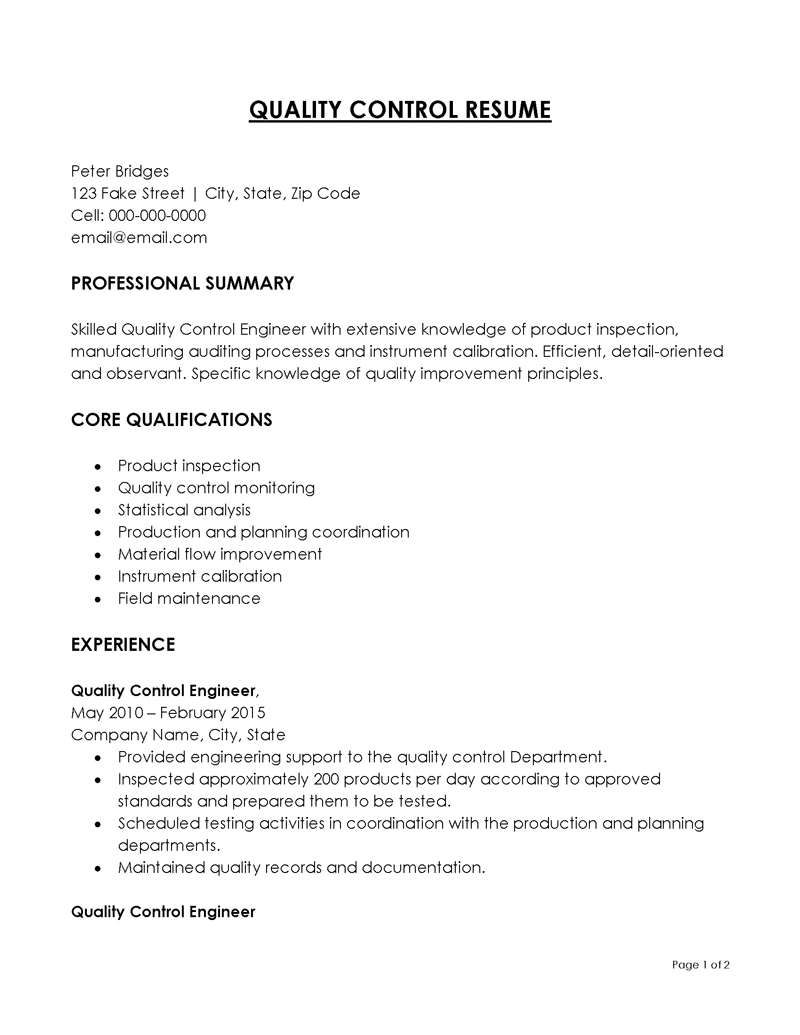
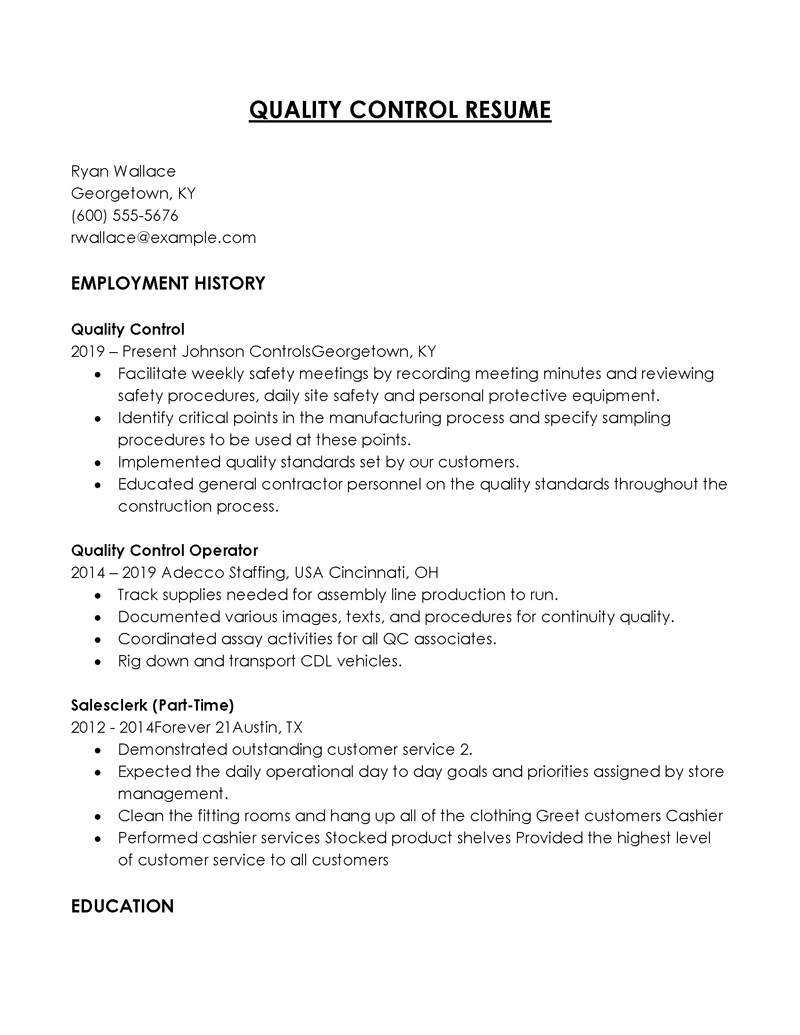
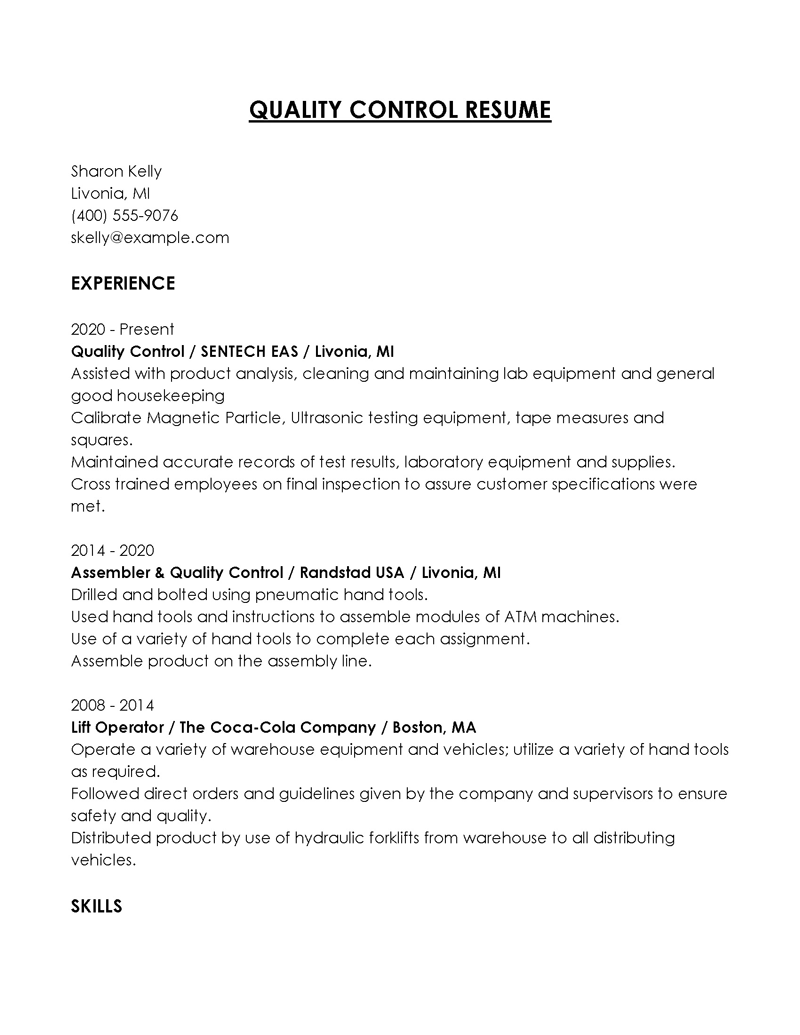
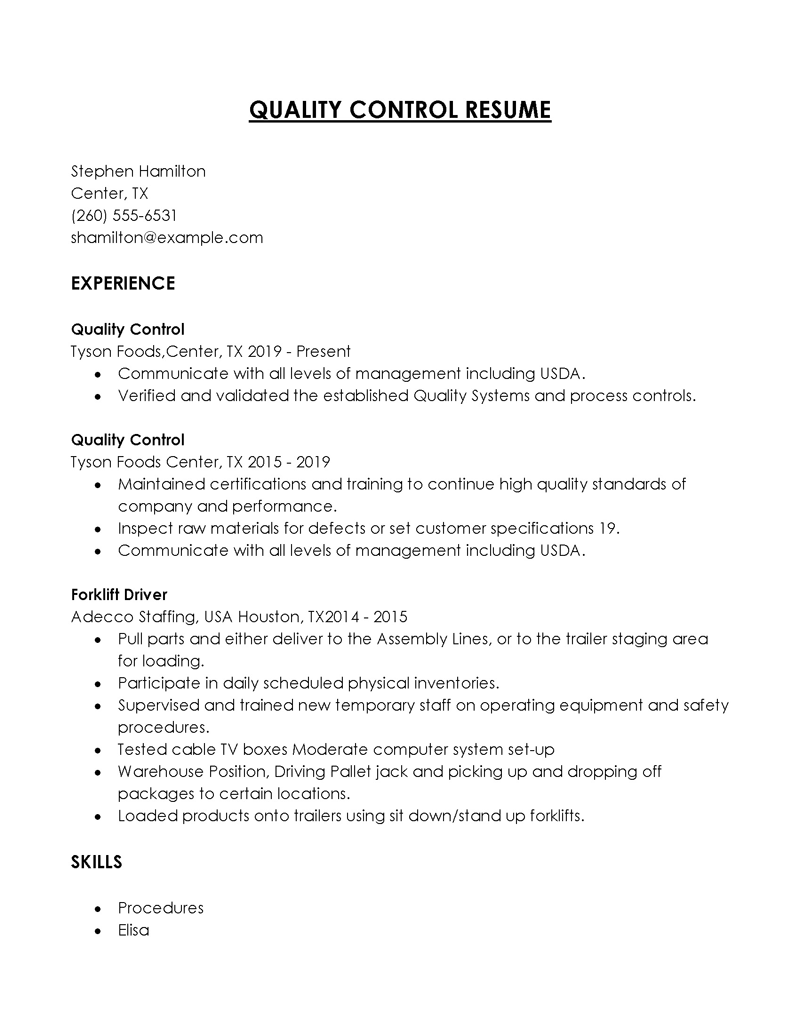
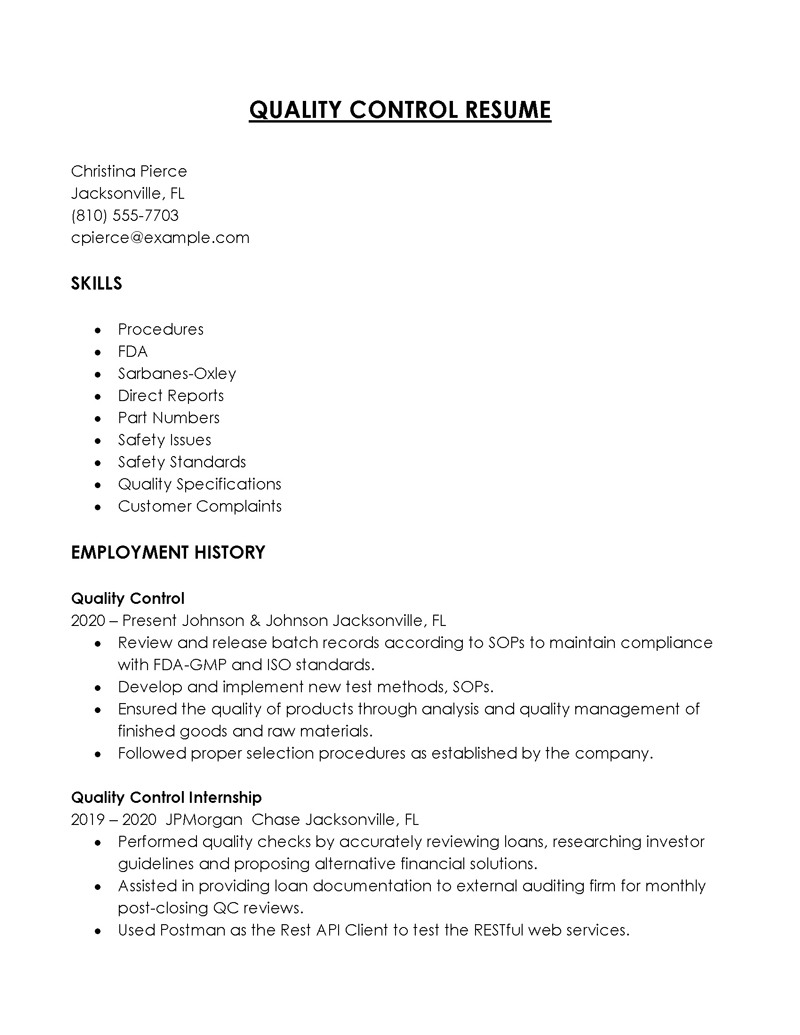
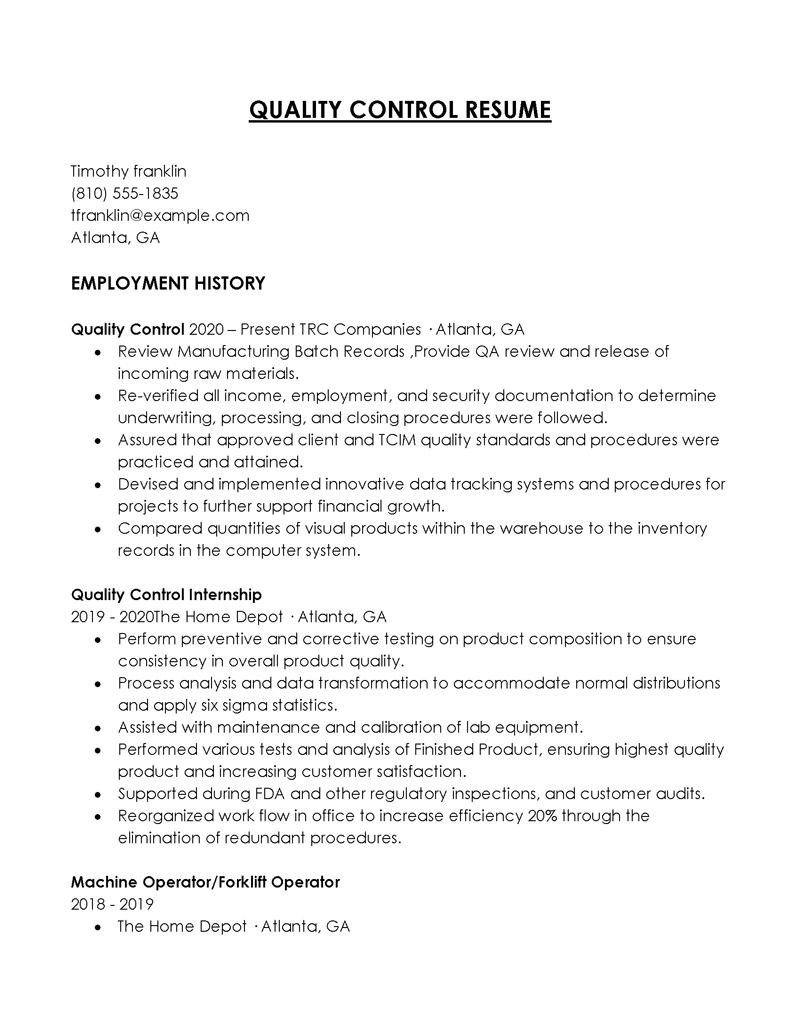
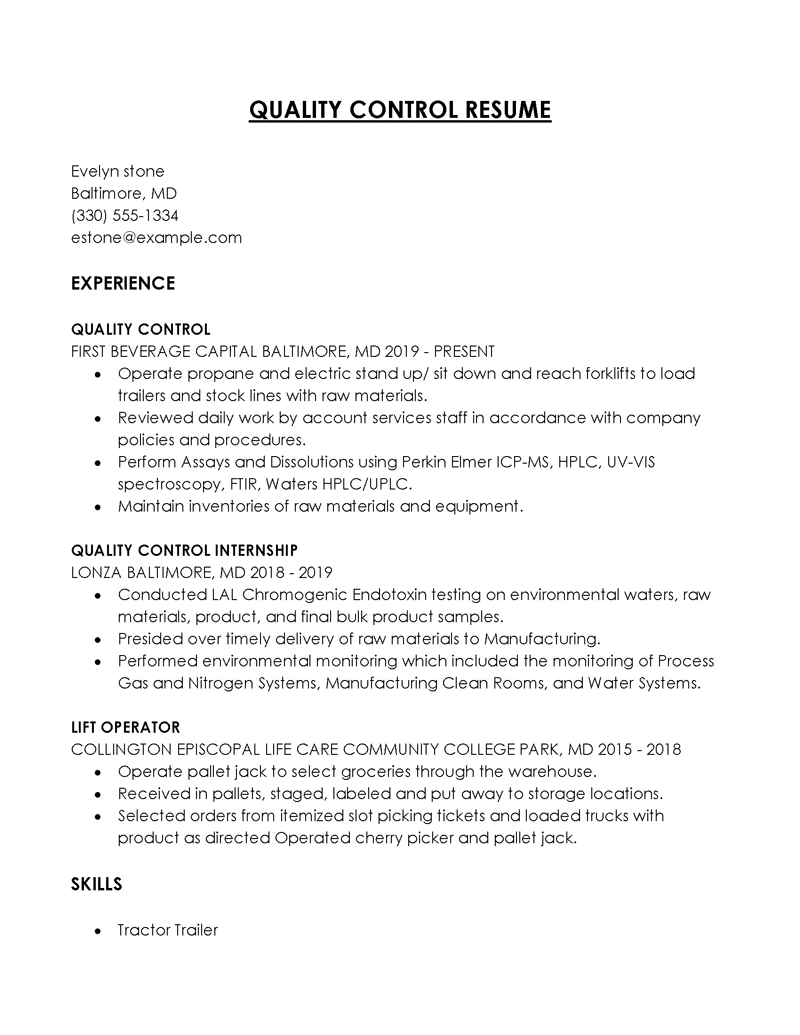
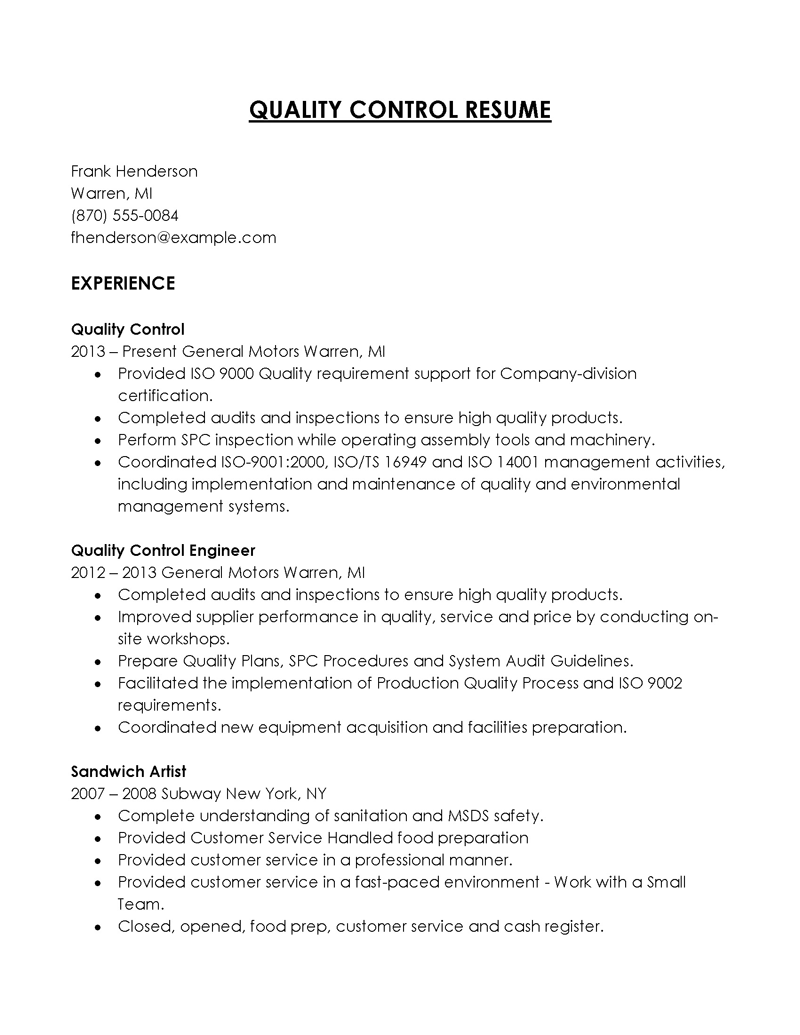
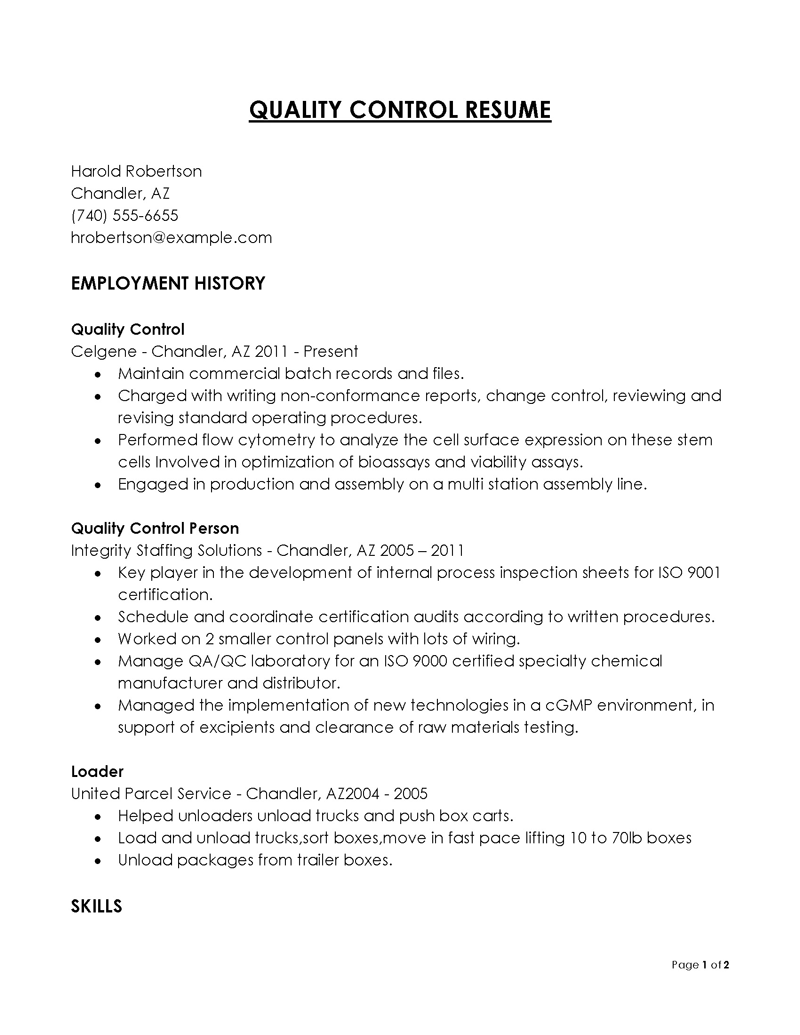
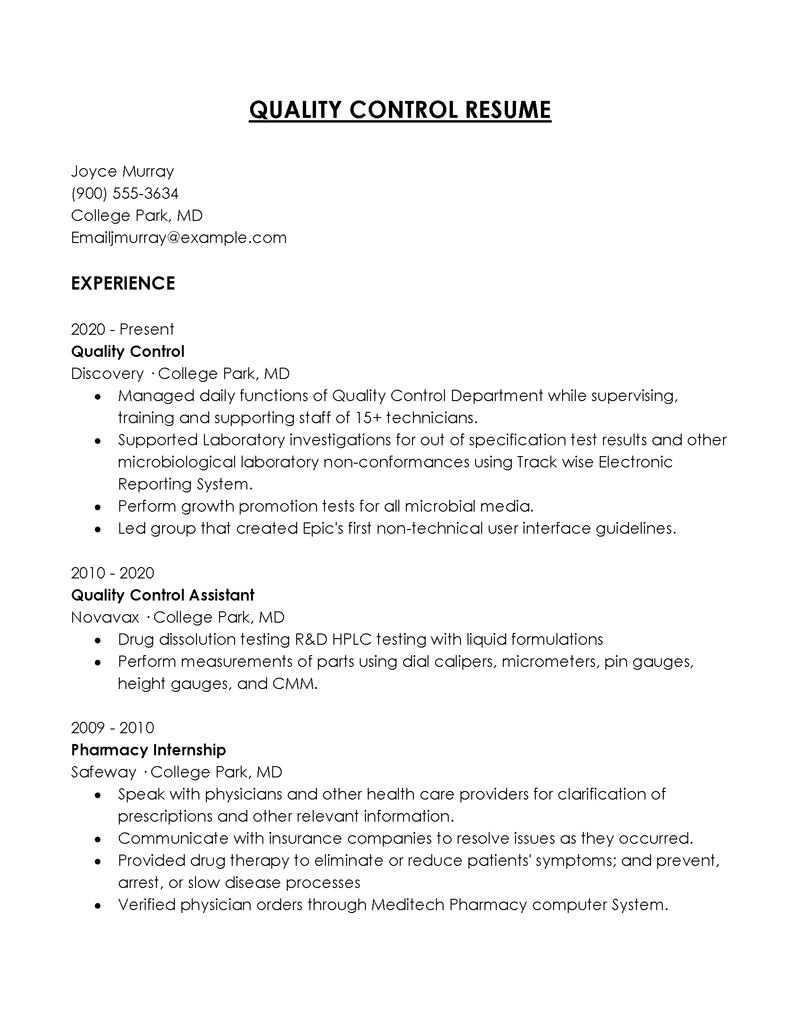
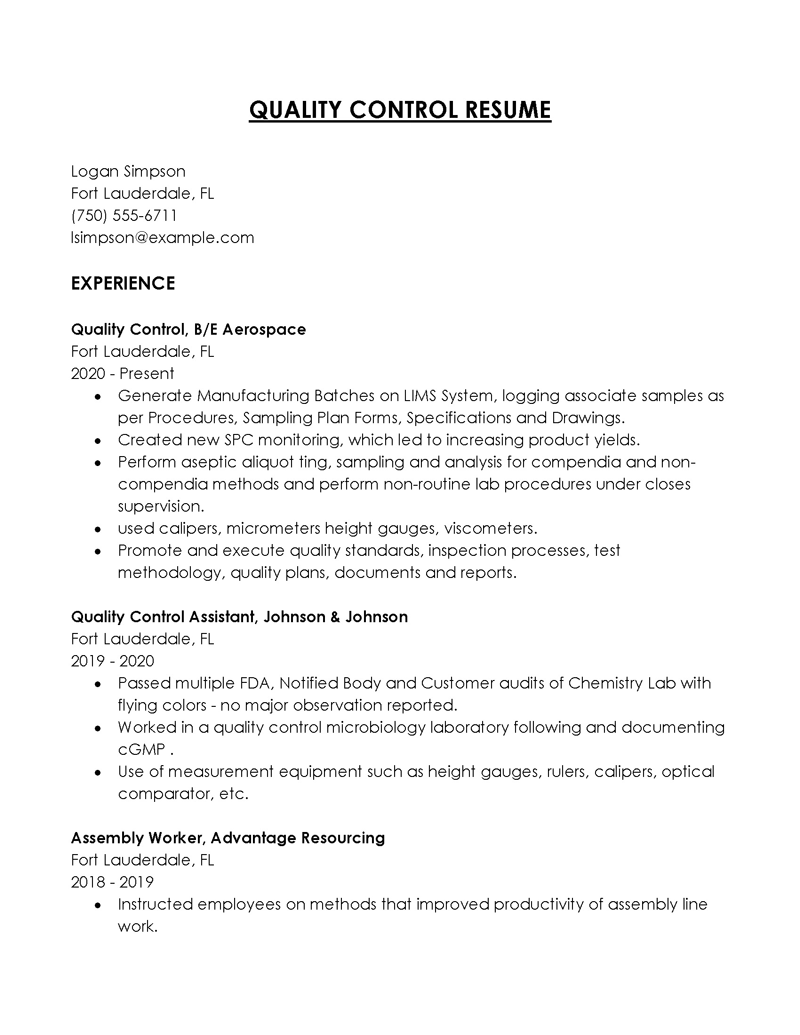
Dos and Don’ts
To attract potential employers through your resume, there are certain writing techniques you can employ. At the same time, there are things you should avoid so as not to compromise your resume’s quality.
The do’s include:
- Use the right resume template: Ensure that you select a suitable template to write your resume. Consider the company culture you’re applying for and the requirements that the employer prioritizes. Using the proper resume template will ensure your resume looks professional and that it can find its way through all stages of the application, from initial screening to interview.
- Tailor your resume to the job listing: The resume’s contents should reflect the language used in the job listing. This way, the employer can be sure the material is relevant and consistent with the job description. Incorporate the appropriate keywords – if the job description uses “quality improvement,” do not use “quality enhancement.”
- Use metrics: Quantify your experience in the following ways; “Reduced waste by 30%”, “Increased revenues by $1.3 million,” or “Recruited and directed a team of five people.” Using metrics to substantiate and quantify claims is more persuasive to employers.
- Be relevant: Be sure to include information about your educational background and professional career in the resume that relates to the job you are applying to and follows industry standards.
- Make your resume ATS friendly: Most employers nowadays use ATS in the recruitment process. The system collects, scans, organizes, and ranks resumes based on predetermined criteria. Recruiters then review the highest-ranked resumes. So, you should aim to make sure you bypass the ATS. You should use the right keywords and phrases to make your resume ATS-compatible.
- Get your resume professionally reviewed: You can have your resume scrutinized by a few industry experts. These could be your colleagues, supervisors, or mentors. Some of the parameters used to determine the quality of your resume include:
-Resume formatting (the font, font size, margins, order of sections, etc.)
-Content relevance
-Compliance with industry norms
-ATS compliance
-Recruiter friendliness
-Design compatibility
-Performance assessment
-Conversion scope
-Global compatibility
The things you should avoid when writing a resume include:
- Don’t overuse jargon: Remember, your resume should be comprehensive to a recruiter and the person who will ultimately interview you, who may sometimes be an HR representative. Keep it simple and clear, and use layman’s terms where possible. So avoid using too many acronyms and technical terms.
- Don’t focus on the negative: The resume shouldn’t focus on negatives that occurred in your previous jobs. While defects and challenges are prominent in quality control, this is not the place to discuss them. Focus on the positives as this will be more convincing to recruiters.
- Don’t forget to proofread: Use the spelling and grammar checker to review your resume before submitting it. Read it aloud as this is the best way to spot errors. Error-free resumes show you are attentive to details which is a desirable trait.
Key Takeaways
- Always remember, there’s no “one-size-fits-all” approach to writing an effective resume. It all boils down to your unique experiences and how you can frame them to best showcase your skills and fit the job requirements.
- Always try to create an ATS-compliant resume, as most employers are using ATS to review the resume.
- Look for assistance from people with seniority in your career and areas of expertise to ensure that your resume showcases what recruiters are looking for in a quality control specialist.
- Focus on your successes and achievements, use a clear and concise writing style, and ensure you proofread carefully to avoid errors.
- You should provide your contact details as it is important to provide the recruiter with the means to reach you.
- Ensure all the sections of a standard resume are included. They include a summary/objective statement, skills, experience, education, and training.








